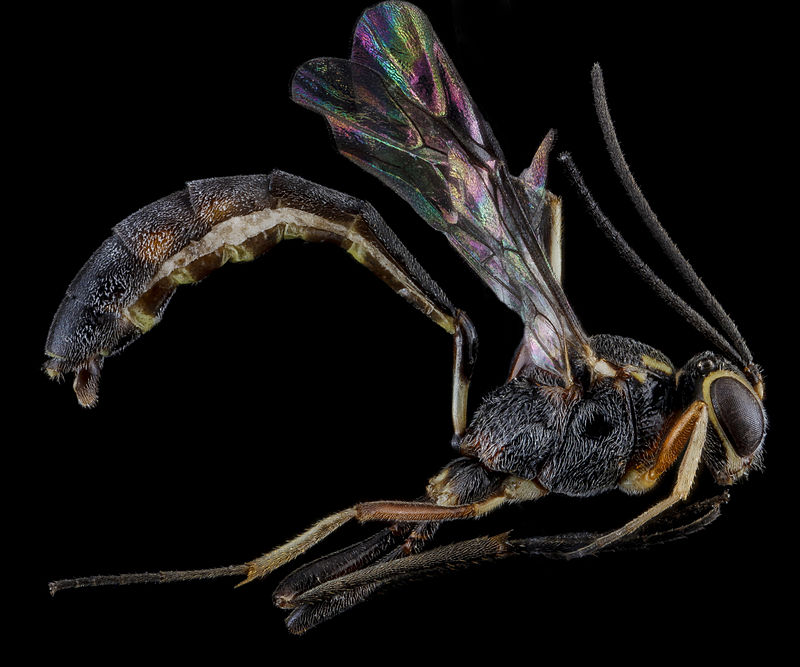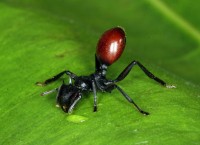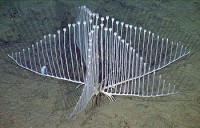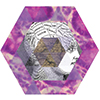No, don’t be ridiculous
The old man was deeply troubled. Beyond his book-lined study the apparently peaceful scene masked a world of unrestricted savagery. Once, on a sunny morning, he had written how in the struggle for existence “no fear is felt … death is generally prompt [while] the vigorous, the healthy, and the happy survive and multiply”. Now he knew this consolatory passage to be bogus. A benevolent Universe? Not in the grave-yard of Malvern Priory, nor for that matter in the remorseless activity of that little horror, the ichneumon-fly. Actually a wasp, the female employs the ovipositor first to paralyze the host (typically grub or caterpillar) and then to lay her eggs. Hatching they proceed to consume their living home from the inside, ultimately to erupt to freedom and so complete a life cycle of imposed agony. Is this insect a totem of existentialist despair or actually a thing of austere beauty? From stroking his beard, the man let his fingers drum on the desk, but eyes once glittering with scientific curiosity had long since faded. The small gravestone, inscribed Anne Elizabeth Darwin, was the metaphysical ichneumon that had drilled her father’s heart.
Yes, of course
Blind the watchmaker may be, but the ichneumon remains a near-miracle of biological order as she seeks a deeply buried prey. Immobile and invisible how can the ichneumon ever locate the concealed grub? In order to “see”, the female ichneumon runs across the tree, tapping its surface with a hammer-like antenna. It is a sort of sonar; as the returning vibrations travel up the ichneumon’s front legs they are channelled to a complex array of mechano-sensors that dispatch the news to the brain. Target identified, drilling commences. Even if much of the ovipositor is coiled inside the body or when free guided along a groove, its extreme length (up to 14 cm) and thinness (hence the risk of buckling, but essential to minimize friction) represent a major challenge. But the optimal vertical position of the ovipositor is facilitated by elongate legs and an arching of the body using the “wasp-waist” (it was this invention that then gave the wasps a decisive advantage in many other evolutionary spheres). With predators hovering in attendance, drilling needs to be as speedy as possible, but hours of effort are typical. If, however, the tip of the ovipositor was not equipped with cutting teeth and more astonishingly reinforced with substantial quantities of metal (often zinc, sometimes manganese) the process would be much slower.
The ovipositor is also cunningly constructed, consisting of three inter-locking units that channel first paralytic toxins and subsequently the eggs. During the cutting process they neatly slide past each other, but successful interception with the grub demands precise navigation. The controlling muscles are housed in the insect body, but the ovipositor is flexible and is also equipped with mechanical sensors that detect the smallest displacements and chemical “sniffers” to seek out the prey. An exquisite system, but surely only of interest to biologists? Not in the future. Clinical investigations have revealed a brain tumour, inaccessible to orthodox surgery. The surgeon opens the patient’s skull and places the needle-thin probe in position. It is a wonder of engineering, but its direct inspiration is the ichneumon ovipositor. Robotically it navigates precisely to the centre of the cancer and sets about its destruction. Millions of miles from the operating theatre an unmanned vehicle arrives on a remote moon. Deep beneath the surface life may lurk, but how to find out? Flaps open, a robotic arm extends, and the ichneumon mimic drills deep into the ice. This moon lacks an atmosphere and meanwhile other instruments survey the glittering stars.
It all depends on the question
Composed of stardust, our first birth was in the cataclysms of supernovae. Much is made of the strange coincidences that guarantee a universe rich in carbon, but about a quarter of the Periodic Table is essential for life. Some elements are obvious (nitrogen, oxygen, phosphorous, potassium and so on), but what about silicon? Employed by single-celled organisms (such as the photosynthetic diatoms) and in plants like grasses (as phytoliths) at first sight animals eschew this element. In fact, sponges construct exquisite siliceous skeletons, and curiously silicon plays a key role in the first stages of bone formation. But this element finds more unexpected employment.
Take a moment to consider the fate of diatoms as they encounter copepods in the freezing waters near Antarctica, or for that matter deep in the waters of Lake Baikal where their counterparts in the form of amphipods roam. Each have mandibles equipped with a thin but extremely tough capping of silica (a sort of quartz known as α-cristobalite). The diatoms may possess an ingeniously designed crush-resistant skeleton, but it is out-classed by these crustacean teeth. Teeth come in all shapes and sizes but they are united in their ability to combine strength with flexibility. How do the quartz jaws of copepods manage? Their ingenious solution is to incorporate pads of a natural elastic (the protein resilin, also widely used by insects). While these animals play the Rock-Scissor-Paper game with silica, other animals turn to metals. Seldom as crystalline masses, but usually cross-linked with amino-acids (histidine is a favourite) and a halogen (often chlorine). If ovipositors can brandish zinc tips, so scorpion stings and spider fangs are similarly hardened. As leaf-cutters ants gather their harvest, termites chew their way through dry wood, and beetles infest stores full of beans, they too employ razor-sharp, zinc-impregnated mandibles. Out to sea voracious bristle-worms and hunting arrow-worms deliver death with either zinc-tipped teeth or as alternatives manganese and even copper.
And what about that de rigeur accompaniment to any decent horror film, the brute with steel teeth? Can nature oblige? In vertebrates red coloured teeth do not point to appalling dental hygiene but the weaving of substantial quantities of iron into the enamel. Enhancing hardness (and perhaps resistance to acids) animals as diverse as fish (are you surprised these include piranhas?) and salamanders, as well as shrews (famous for their voracious appetites) and other mammals (including gnawing rodents and their extinct avatars, the multituberculates) have taken the ferrous option. But perhaps the nearest thing to a natural iron file is found in the ribbon of teeth (biologists cheer at the name radula, but Caesar meant a scraper) that enables molluscs like the limpet and chiton to rasp rocks draped with nutritious algae and bacteria. Using a template of chitin each tooth forms an exceptionally strong cap of iron oxides (goethite in limpets, magnetite in chitons) situated above a less tough but still mineralized core that includes phosphates and silica. It sounds simple, until you look at the nano-structures. Exquisite arrangements of rods and fibres confer immense strength with resilience. Given the greater hardness of the leading edge as against the trailing margin, each tooth is also conveniently self-sharpening. Across the planet ovipositors and teeth deliver death and impose destruction, but take a moment to admire their exquisite engineering. Very dangerous, but also beautiful.
Text copyright © 2015 Simon Conway Morris. All rights reserved.
Further reading
Anderson, M.A and Miller, B.T. (2011) Early iron deposition in teeth of the Streamside salamander, Ambystoma barbouri. Journal of Herpetology 45, 336-338.
Barber, A.H. et al. (2015) Extreme strength observed in limpet teeth. Journal of the Royal Society Interface 12, 20141326.
Birkedal, H. et al. (2006) Halogenated veneers: Protein cross-linking and halogenation in the jaws of Nereis, a marine polychaete worm. ChemBioChem 7, 1392-1399.
Bone, Q. et al. (1983) The structure and composition of the teeth and grasping spines of chaetogaths. Journal of the Marine Biological Association, UK 63, 929-939.
Broad, G.R. and Quicke, D.L.J. (2000) The adaptive significance of host location by vibrational sounding in parasitoid wasps. Proceedings of the Royal Society of London, B 267, 2403-2409.
Broomell, C.C. et al. (2008) Role of transition metals in sclerotization of biological tissue. Acta Biomaterialia 4, 2045-2051.
Burrows, C. et al. (2013) Experimental characterisation of a biologically inspired 3D steering needle. International Conference on Control, Automation and Systems 6704141, 1252-1257.
Carlisle, E.M. (1988) Silicon as a trace nutrient. The Science of the Total Environment 73, 95-106.
Cribb, B.W. et al. (2008) Unique zinc mass in mandibles separates drywood termites from other groups of termites. Naturwissenschaften 95, 433-441.
Cruz, R. and Farina, M. (2005) Mineralization of major lateral teeth in the radula of a deep-sea hydrothermal vent limpet (Gastropoda: Neolepetopsidae). Marine Biology 147, 163-168.
Cruz, R. et al. (1998) Minerals of the radular apparatus of Falcidens sp. (Caudofoveata) and the evolutionary implications for the phylum Mollusca. Biological Bulletin 194, 224-230.
Dumont, M. et al. (2014) Structural and functional characterization of enamel pigmentation in shrews. Journal of Structural Biology 186, 38-48.
Eriksson, M. and Elfman, M. (2000) Enrichment of metals in the jaws of fossil and extant polychaetes – distribution and function. Lethaia 33, 75-81.
Faivre, D. and Godec, T.U. (2015) From bacteria to mollusks: The principles underlying biomineralization of iron oxide minerals. Angewandte Chemie-International Edition 54, 4728-4747.
Fontaine, A.R. et al. (1991) Cuticular metal hardening of mouthparts and claws of some forest insects of British Columbia. Journal of the Entomological Society of British Columbia 88, 45-55.
Frasson, L. et al. (2012) Experimental evaluation of a novel steerable probe with a programmable bevel tip inspired by nature. Journal of Robotic Surgery 6, 189-197.
Gao, Y. et al. (2007) Bioinspired drill for planetary sampling: Literature survey, conceptual design, and feasibility study. Journal of Spacecraft and Rockets 44, 703-709.
Gibbs, P.E. and Bryan, G.W. (1980) Copper – the major metal component of glycerid polychaete jaws. Journal of the Marine Biological Association, UK 60, 205-214.
Gordon, L.M. and Joester, D. (2011) Nanoscale chemical tomography of buried organic-inorganic interfaces in the chiton teeth. Nature 469, 194-198.
Gordon, L.M. et al. (2015) Amorphous intergranular phases control the properties of rodent tooth enamel. Science 347, 746-750.
Grunenfelder, L.K. et al. (2014) Stress and damage mitigation from oriented nanostructures within the radular teeth of Cryptochiton stelleri. Advanced Functional Materials 24, 6093-6104.
Hillerton, J.E. and Vincent, J.F.V. (1982) The specific location of zinc in insect mandibles. Journal of Experimental Biology 101, 333-336.
Hillerton, J.E. et al. (1984) The presence of zinc or manganese as the predominant metal in the mandibles of adult, stored-product beetles. Journal of Stored Products Research 20, 133-137.
Hua, T-E. and Li, C-W. (2007) Silica biomineralization in the radula of a limpet Notoacmea schrenckii (Gastropoda: Acmaeidae). Zoological Studies 46, 379-388.
Kundanati, L. and Gundiah, N. (2014) Biomechanics of substrate boring by fig wasps. Journal of Experimental Biology 217, 1946-1954.
Le Lannic, J. and Nénon, J.P. (1999) Functional morphology of the ovipositor in Megarhyssa atrata (Hymenoptera, Ichneumonidae) and its penetration into wood. Zoomorphology 119, 73-79.
Lichtenegger, H.C. et al. (2005) Distribution and role of trace transition metals in Glycera worm jaws studied with synchroton microbeam radiation. Chemistry of Materials 17, 2927-2931.
Liddiard, K.J. et al. (2004) Mineralisation in the teeth of the limpets Patelloida alticostata and Scutellastra laticostata (Mollusca: Patellogastropoda). Molluscan Research 24, 21-31.
Lu, D. and Barber, A.H. (2012) Optimized nanoscale composite behaviour in limpet teeth. Journal of the Royal Society Interface 9, 1318-1324.
Mekhanikova, I.V. et al. (2012) Specific features of mandible structure and elemental composition in the polyphagous amphipod Acanthogammarus grewingkii endemic to Lake Baikal. PLoS ONE 7, e43073.
Menon, C. et al. (2006) Bio-inspired micro-drills for future planetary exploration. Proceedings of CANEUS 2006, e11022.
Michels, J. and Gorb, S.N. (2015) Mandibular gnathobases of marine planktonic copepods – feeding tools with complex micron- and nanoscale composite architectures. Beilstein Journal of Nanotechnology 6, 674-685.
Michels, J. et al. (2012) Tools for crushing diatoms – Opal teeth in copepods feature a rubber-like bearing composed of resilin. Scientific Reports 2, e465.
Michels, J. et al. (2015) New insights into the complex architecture of siliceous copepod teeth. Zoology 118, 141-146.
Morgan, T.D. et al. (2003) Metals in mandibles of stored product insects: do zinc and manganese enhance the ability of larvae to infest seeds? Journal of Stored Products Research 39, 65-75.
Polidori, C. et al. (2013) Breaking up the wall: Metal-enrichment in ovipositors, but not mandibles, co-varies with substrate hardness in gall-wasps and their associates. PLoS ONE 8, e70529.
Politi, Y. et al. (2012) A spider’s fang: How to design an injection needle using chitin-based composite material. Advanced Functional Materials 22, 2519-2528.
Quicke, D.L.J. and Fitton, M.G. (1995) Ovipositor steering mechanisms in parasitic wasps of the families Gasteruptiidae and Aulacidae (Hymenoptera). Proceedings of the Royal Society of London, B 261, 99-103.
Quicke, D.L.J. et al. (1998) Manganese and zinc in the ovipositors and mandibles of hymenopterous insects. Zoological Journal of the Linnean Society 124, 387-396.
Saunders, M. et al. (2009) Characterization of biominerals in the radula teeth of the chiton, Acanthopleura hirtosa. Journal of Structural Biology 167, 55-61.
Schofield, R. and Lefevre, H. (1989) High concentrations of zinc in the fangs and manganese in the teeth of spiders. Journal of Experimental Biology 144, 577-581.
Schofield, R.M.S. and Lefevre, H.W. (1992) PIXE-STIM microtomography: zinc and manganese concentrations in a scorpion sting. Nuclear Instruments and Methods in Physics Research, B 72, 104-110.
Schofield, R.M.S. et al. (2011) Leaf-cutter ants with worn mandibles cut half as fast, spend twice the energy, and tend to carry instead of cut. Behavioral Ecology and Sociobiology 65, 969-982.
Shaw, J.A. et al. (2009) The chiton stylus canal: An elemental delivery pathway for tooth cusp biomineralization. Journal of Morphology 270, 588-600.
Shellis, K.P. and Berkovitz, K.B. (1976) Observations on the dental anatomy of piranhas (Characidae) with special reference to tooth structure. Journal of Zoology, London 180, 69-84.
Smith, T. and Codrea, V. (2015) Red iron-pigmented tooth enamel in a multituberculate mammal from the Late Cretaceous Transylvanian “Hateg Island”. PLoS ONE 10, e0132550.
Sone, E.D. et al. (2007) Biomineralization of limpet teeth: A cryo-TEM study of the organic matrix and the onset of mineral deposition. Journal of Structural Biology 158, 428-444.
Sparks, N.H.C. et al. (1990) An analytical electron microscopy study of iron-rich teeth from the butterflyfish (Chaetodon ornatissimus). Journal of Experimental Biology 151, 371-385.
Strait, S.G. and Smith, S.C. (2006) Elemental analysis of Soricine enamel: Pigmentation variation and distribution in molars of Blarina brevicaudata. Journal of Mammalogy 87, 700-705.
Townes, H. (1975) The parasitic Hymenoptera with the longest ovipositors, with descriptions of two new Ichneumonidae. Entomological News 86, 123-127.
van der Wal, P. et al. (2000) Radular teeth as models for the improvement of industrial cutting devices. Materials Science and Engineering, C 7, 129-142.
Vilhelmsen, L. and Turrisi, G.E. (2011) Per arborem ad astra: Morphological adaptations to exploiting the woody habitat in the early evolution of Hymenoptera. Arthropod Structure and Development 40, 2-20.
Vilhelmsen, L. et al. (2001) Host location and oviposition in a basal group of parasitic wasps: the subgenual organ, ovipositor apparatus and associated structures in the Orussidae (Hymenoptera, Insecta). Zoomorphology 121, 63-84.
Wang, Q-Q. et al. (2013) Phase transformations and structural developments in the radular teeth of Cryptochiton stelleri. Advanced Functional Materials 23, 2908-2917.






